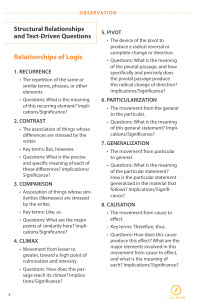
When God revealed himself in Scripture, he inspired words that the audiences of the Bible could largely understand and that we can understand still. In other words, he spoke in human languages. He used the kinds of thought patterns that he created as part of his universe, patterns of understanding that we encounter every day.
The ways in which two thoughts connect to each other is not infinite. The most basic way that two thoughts might connect is by repeating the same thought, repetition. Similarly, two thoughts might be similar or different – they might compare or contrast. This is the way God made the world, and the Bible demonstrates these same thought patterns.
The following is a list of some major ways that one block of biblical text might relate or “connect” to a block of biblical text that follows it:
- Contrast
Two sections in a book of the Bible can be significantly different than each other. We can see this dynamic in 1 and 2 Kings in contrasts between good and bad kings. Sometimes, we see a contrast between a southern king of Judah (who is righteous) or a northern king (who is wicked). Consider also the contrast between Josiah (a good king) and his father Manasseh (a bad king) in 2 Kings 21-23. Contrast is one of the major patterns of thinking God built into the world.
- Comparison
Two sections in a book of the Bible can be similar to each other – they can involve either an explicit or implicit comparison . One example is a “sandwich” structure. In Mark 11:12-25, Jesus curses a fig tree, overturns the tables in the temple, then the fig tree withers. The event in the temple is “sandwiched” or “intercalated” between the story of the fig tree, setting up an implicit comparison between the two events. Mark wants us to see what Jesus does in the temple through the lens of the fig tree – the two events are like each other. Just as the fig tree did not bear fruit and was judged, Israel had not born fruit and would be judged.
- General to Specifics
Sometimes a book will have a key verse. A key verse is like a general statement that then plays out in more detail in the rest of the book. Acts 1:8 serves this role. It tells how the apostles would witness to the resurrection in Jerusalem (Acts 1-7), in Judea and Samaria (Acts 8-12), and to the ends of the earth (Acts 13-28). See how Acts 1:8 becomes like a map for the rest of Acts. There are many other examples of key verses like this one (e.g., 1 Cor. 1:10).
-
Specifics to the General
The direction can also go in the opposite way. You might see details that are then summed up or captured in a general statement later. For example, the last verse of Matthew 5 captures the overall sense of the rest of the chapter: “Therefore, just as your heavenly Father is complete in showing love to everyone, so also you must be complete” (CEB). You might say that Matthew 5:48 “generalizes” the overall sense of Matthew 5:21-42 and how God calls us to go beyond merely doing the right thing to doing the right thing out of love toward others.
- Introduction, Background, and Conclusion
Across history, books have typically begun and closed with introductions and conclusions. It is no coincidence that many books of the Bible have something like an introduction and conclusion at their beginning and end. Additionally, many books begin with background information after their introduction. You might consider the stories of Jesus’ birth to provide background to his ministry.
- Cause to Effect
Another pattern we see in the books of the Bible is a movement from cause to effect. This can happen in terms of events, such as when the Greek-speaking church is scattered after Stephen is stoned (Acts 8:1). You might call this pattern “real-world cause and effect.” It can also happen with ideas. We mentioned above that Romans 12 marked a transition between the main sections of Romans. The relationship between the first part and the second is one of “logical” causation. Given what is taught in Romans 1-11, the application in Romans 12-15 follows. This is a movement of thought from cause to effect, a pattern that God created in the world.
It is worth stopping here to point out an important dimension to surveying. There are relationships between the parts of an outline. In the case of Romans, the second half follows or “is a result of” the truth of the first half. There is a sort of “cause-effect” relationship between the two sections.
The parts of an outline virtually always relate to each other in some logical way. After outlining a book or section, the next step is to identify the way the thought in each section relates to the others. This page sets out the main possibilities.
- Substantiation
When you back up a claim you have made, you are moving in the opposite direction of cause to effect. You are giving reasons or causes for a claim you have made, moving from effect to cause. You might say you are “substantiating” what you have said. For example, there is a sense in which Hebrews 11, the “faith chapter,” is “backing up” or supporting what the author has just said at the end of Hebrews 10:36-39. Why should they persevere? Why should they keep going in faith? Because God is faithful, as all the examples in Hebrews 11 show.
- Statement of Purpose
Every once in a while, a biblical text will tell us why a book was written. This is a statement of purpose. It is very important to notice because it gives us important context for the book. John 20:30-31 is probably the best known example.
It may seem rather dry to look for these sorts of patterns. After all, we process these patterns naturally all the time in our everyday conversations. But understanding them – bringing them out into the open – helps us become more conscious of what the biblical text is saying. It helps us understand the biblical text better.
- Problem to Solution/Question and Answer
A special kind of cause-effect pattern is when one part of a text presents a problem that is then later solved. The first half of Romans follows this pattern. In Romans 1:18-3:20, we get humanity’s problem – all have sinned. Then Romans 3:21-4:25 gives the solution: Christ’s faithful death and our trust in what God has done through it.
Stories
There are a couple patterns we especially see in stories. Since more of the Bible is story than any other genre, these are significant features to look out for.
- Climax
Stories often build tension until it reaches a peak only then to be resolved at least to some extent. We call this a climax in a story. The resurrection is the climax of Matthew, Luke, and John’s Gospels. Interestingly, the same story can be told in more than one way. The climax in Mark’s Gospel is at the crucifixion, with the resurrection more as an epilogue in the way God inspired him to tell the story.
- Turning Points (Pivots)
A story can also have a turning point. In the Gospel of Mark, the tone is one of action, growth, and positivity until Peter confesses Jesus as the Christ in Mark 8:27-33. It is then that Jesus tells the disciples that he is going to die. The tone from then on in the Gospel is one of foreboding, and Jesus withdraws more into more private interactions.
Literary Patterns
There are some ways that you can structure text so that meaning can “piggy-back” on it. These structures assist meaning although they are not part of the meaning itself.
- Sandwiches
We mentioned the “intercalation” way of structuring text above in our discussion of comparison. In a sandwich structure, one thread (the bread) is interrupted by another story (the jelly or whatever you prefer on your sandwiches). The two stories thus inform the meaning of the other, like the story of the fig tree gives insight into what Jesus does in the temple. You might call this an A B A pattern
- Interchange
Sections can go “back and forth.” They can alternate. An example of this pattern is in Hebrews, where the text moves back and forth between “teaching” and “preaching” in what we might call an A B A B pattern. Hebrews 1:1-14 has teaching. Hebrews 2:1-4 has preaching. Hebrews 3:1-6 has teaching. Hebrews 3:7-4:13 has preaching.
There is also a clear relationship between this teaching and preaching. The preaching follows naturally from the teaching. In other words, there’s a cause effect relationship between the two. Because Christ is greater than angels, Moses, and so forth, the audience should continue in faith. We again see that the way the text is structured “literarily” is used to convey meaning.
- Inclusio
Another literary pattern we sometimes see in the Bible is called an “inclusio.” An inclusio helps you see when a section is beginning and ending because similar words or themes appear at the beginning and end of a section. For example, Hebrews 1:5 and Hebrews 1:13 start off with a very similar expression: “To which of the angels did he say.” It’s a signal that a section of text begins and ends.
The whole Gospel of Matthew has this sort of a bracket at its beginning and end. Matthew 1:23 announces that Jesus will be “Immanuel,” which means “God with us.” Then at the end of the Gospel, Jesus tells the disciples, “I will be with you to the ends of the earth” (Matthew 28:20). Jesus as God with us begins and ends the Gospel.
- Chiasm
A final literary pattern is called a “chiasm.” This is a pattern along the lines of A B C B A, but in theory it could go much longer. In general, we should be suspicious of suggestions of chiasms that go too far (like those that see patterns that are incredibly complex and cover a whole book). However, the book of Jonah does have a fairly simple chiastic dimension:
- A – chapter 1: Jonah acts unrighteously.
- B – chapter 2: Jonah obeys.
- B – chapter 3: Jonah obeys.
- A – chapter 4: Jonah acts unrighteously.
Once you have a sense of these ways in which thoughts can relate to each other, you might just begin to see them everywhere, not just in the Bible but in other books, movies, even in conversations. They are the way we think. They are the way we communicate. And God u
